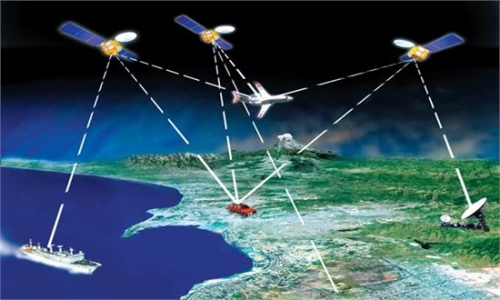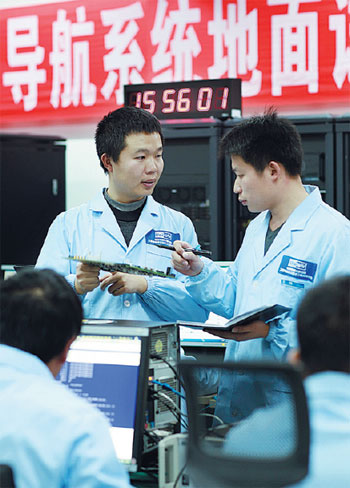Scientist and his 300-strong team have their eyes on global satellite coverage by 2020

For the past 20 years, Wang Feixue and his team have been working on China's Beidou Navigation Satellite System. Now the pace is being stepped up to "lay out the stars" and form a constellation of satellites orbiting the Earth.
On March 30, the Beidou system sent its first satellite into orbit, marking the first stage of its upgrade from a regional service to global coverage by 2020.
Wang, 44, heads the Center for Satellite Navigation and Positioning Technology at the National University of Defense Technology in Changsha, Hunan province.
The 300-strong research team, with an average age below 30, conducts most of the Beidou system's research and development.
"The Beidou global system will focus on improving navigation precision and expanding its application in the Asia-Pacific region," Wang said.
"Because the profitable period for the second generation of satellite navigation systems has passed, further industrial breakthroughs will depend on innovation of the application model and progress of the system," he added.
China will launch four more Beidou network satellites and build seven receiving stations nationwide by the end of this year. The system will have 35 satellites, five of them in geostationary orbit, and achieve higher accuracy by being able to focus to within 1.5 meters of a given point rather than the present 10 meters by 2020.
Wang said some of Beidou's unique technological features, such as the short text messaging service, will find greater markets in the Asia-Pacific region. Compared with the expensive satellite phone service, Beidou's text messaging is free of charge and allows users to send up to 60 Chinese characters.
"The short messaging service was planned to be a byproduct, but it has surprisingly become one of Beidou's most popular functions. It not only shows where you are but also lets others know where you are through communication," he said.
Beidou's short message service first attracted public attention during the rescue work after a magnitude-8.0 earthquake in Wenchuan, Sichuan province, in 2008.
"When power was cut off in the disaster area, Beidou still managed to send back signals to guide rescue teams," Wang said.
"It not only illustrated Beidou's powerful functions at a difficult time and in difficult terrain but also reminded people of Beidou's significance as part of China's information infrastructure," he added.
Wang joined the Beidou project in 1995, as a doctoral student at the National University of Defense Technology. At that time, development of the system had stagnated for almost a decade because scientists could not overcome a technological bottleneck on signal acquisition.
Wang sensed that a potential answer to that bottleneck lay in the burgeoning digital technology.
With his classmate Ou Gang, who is now a professor at the university and senior researcher of the Beidou project, Wang devoted his time to an all-digitalized signal acquisition solution that stumped many of the country's top scientists.
Three years later, hypothesis was turned into reality with the aid of one computer and funding of $6,000. All of Chinese academia was stunned.
"Many said it was a miracle that such young students had achieved a remarkable breakthrough because it was the first time that digital technology had been applied to China's aerospace industry," Ou said.
Scientists at the center prepare for the launch of the first satellite of the Beidou global system in January. Photos provided to China Daily
In late 2007, a second-generation Beidou satellite lost contact with its control center due to complicated electromagnetic interference. If the problem remained unresolved for more than three months, it would not only turn the satellite into "space junk" but also delay the launch of subsequent satellites.
Industry experts came up with two solutions. The first involved changing to another signal frequency to avoid the interference, while the second required installing stronger anti-interference shields.
"It is technically easy to implement the first method, but changing the signal frequency means the waste of previously launched satellites and the potential for future interference," Wang said.
At such a critical juncture, tremendous pressure fell on Wang and his team to come up with the remedy. After three months of sleepless nights, he once again succeeded in tackling the problem by enhancing the anti-interference capability a thousandfold.
"As one of the Beidou system's leading scientists, Wang spends on average 200 days each year on business trips and at testing grounds. His hardworking spirit has inspired every member on the Beidou team," Ou said.
China is the third country to develop its own satellite navigation system, following the United States' GPS and Russia's GLONASS. It began providing positioning, navigation, timing and short messaging services to civilian users in China and neighboring countries in the Asia-Pacific region toward the end of 2012.
Ran Chengqi, director of the China Satellite Navigation Office, which oversees the Beidou project, said China is cooperating on satellite navigation with surrounding countries, such as Australia, Indonesia, Pakistan and Singapore.
"We are helping some countries in Southeast and Southern Asia plan for their ground applications of the Beidou system and are building infrastructure so they can better use the system," Ran said.
According to Wang, the next challenge for Beidou is to integrate into the large civilian market, while striving to achieve new technical advances to the system, such as real-time and high-precision positioning technology.
"Competition at the level of civilian use is fierce," Wang said. "GPS has already taken up a large proportion of the market. A country will have to rely on its strong industrial capability to compete in this application area.
"Fortunately, China has a strong industrial system. We are working closely with microchip providers like Huawei to further integrate communication and navigation. Hopefully, we will enter the civilian market within a year or two."



















